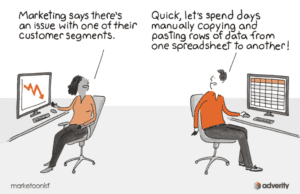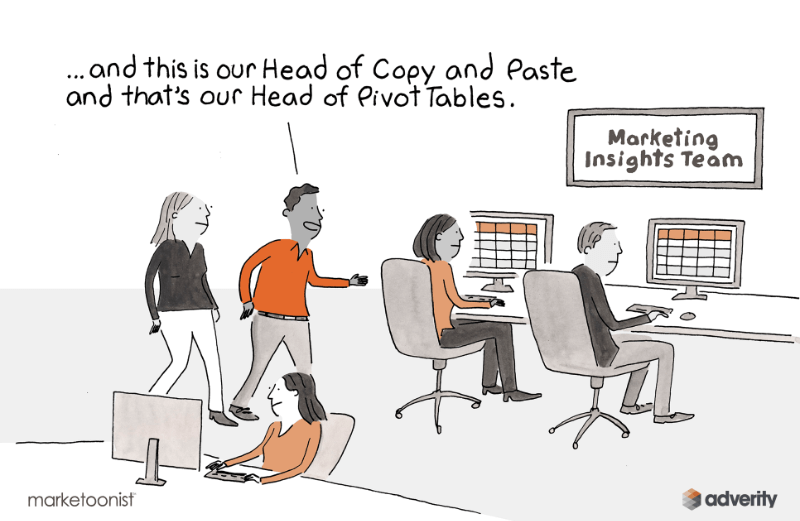In August 2021, Sirkin Research, commissioned by Adverity, surveyed 964 Marketers and Data / Business Intelligence Analysts across the United States, United Kingdom, and Germany about Marketing Analytics. The survey covered topics ranging from current capabilities, key challenges, and strategic priorities of organizations’ use of marketing data and analytical maturity. Respondents represented a large range of industries, including Technology, Marketing Agencies, and eCommerce.
As a marketer and/or business owner, what are some of the challenges you face in terms of analytics? According to Adverity’s latest research:
- 41% of marketers and analysts say manual data wrangling is a significant challenge
- Almost half of CMOs say they lack the ability to measure ROI on marketing spend
Surprised? Well, these are the results they’ve gathered from a survey of 964 marketing professionals. And I suspect most business owners would admit to the same challenges across the business.
Manual data reporting is the key challenge businesses need to overcome in 2022 and businesses owners should be looking at automated data integration platforms that can eliminate this issue. This will not only speed up the time to get better value from their data, but also enable more focus on measuring the ROI on marketing spend and improving visibility over campaigns effectiveness. I’ve included a summary of the research below plus a link to the full report.
Executive Summary
Despite the prevalence of tools and solutions that provide automated data integration, the time and effort required for manual data integration continues to be ranked as the top challenge for marketing professionals. And, with few exceptions, this holds true regardless of job seniority, region, or industry, respondents.
This should be an immediate red flag for marketers and analysts (and indeed, business owners and investors) alike. With more and more data available to businesses, spread out across more and more locations, manually wrangling data via spreadsheets is an increasingly time-consuming and resource-heavy process. And this in turn has important consequences for the business.
First, time spent manually wrangling data prevents staff from working on more valuable projects that can deliver greater value to the business. Second, because of the time required to manually integrate data, the time-to-value is significantly increased. Marketers only ever receive a retrospective view of campaign performance and marketing impact, preventing them from making proactive, or even predictive, strategic decisions.

Thirdly, and most worryingly, manual data wrangling often leads to inaccuracies resulting from human error. Of the 41% of respondents who cited manual data wrangling as a significant challenge, more than half (53%) said they also had a low level of trust in their data due to inaccuracies and mistakes.
Of particular concern is that this lack of trust is significantly bigger among data analysts than marketers highlighting a problematic disconnect between the two roles. While 41% of data analysts say that inaccurate data is a significant challenge, only 30% of marketers agree ranking it their lowest challenge.
This discrepancy should be alarming. Since analysts are the ones working closest to the data, any concerns about inaccuracies or mistakes need to be communicated to their marketer colleagues. Otherwise, key strategic decisions around, for example, budget allocation, are based on data their analysts do not fully trust. And, with the size of marketing spend per month increasing, this could translate into enormous amounts of wasted or misdirected revenue.
Personalised content and audience building
Challenges aside, personalised content and audience building are the clear strategic focus for marketing in 2022. This is unsurprising given concerns around third-party cookie deprecation and the increasing strictness of privacy laws. Content in the future is likely to have to work harder for businesses to gain access to customers’ zero and first-party data and creating a tailored and transparent value proposition is a good strategy for achieving this.
However, despite this campaign reporting being regarded as the lowest strategic priority for 2022, businesses that see themselves as very strong at campaign reporting, are on average 3 times as likely to be very strong at personalised content or audience building and 3.5 times more likely to be very strong in at least one other strategic capability. This speaks very directly to the fact that campaign reporting is the baseline starting point. Ultimately, businesses that choose to invest in campaign reporting are more likely to succeed at improving their personalised content and audience building capabilities. What’s more, 75% of respondents who said they are very strong at campaign reporting will continue to make this area a high priority for investment in 2022 further highlighting the benefits.
The full report also contains comparisons between different industries and a focus on USD, UK and Germany. While marketers and analysts in the US and UK share many of the same challenges and strategic priorities for 2022 as each other, there are nonetheless some key differences. This is of particular interest for international businesses with multiple regional marketing departments.

